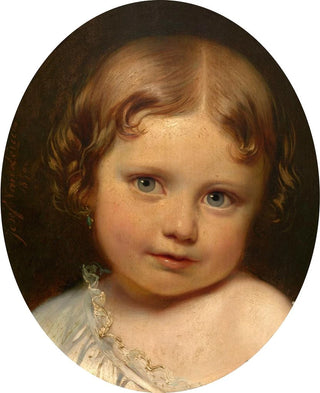Art print | Madame Valentine De Give-Le Delier enfant - Jozef Van Lerius


View from behind

Frame (optional)
In the rich and captivating world of art, some works manage to capture the very essence of innocence and childhood beauty. The art print Madame Valentine De Give-Le Delier enfant - Jozef Van Lerius is a perfect example. This painting, imbued with tenderness and delicacy, immerses us in a world where the purity of childhood is highlighted. Through the sparkling gaze of the child and the meticulous details of their environment, the viewer is invited to explore the subtleties of human emotion, all while being immersed in the aesthetics of the 19th century. The composition, both simple and evocative, reminds us that art can transcend time and space, offering a window into moments of life frozen forever.
Style and uniqueness of the work
The work of Jozef Van Lerius stands out for its realistic approach, which manages to marry technical finesse with psychological depth. In this art print, light plays a central role, illuminating the child's face with an almost tangible softness. The colors, carefully chosen, evoke a warm and welcoming atmosphere, while the details of the costume and background testify to a meticulous observation of reality. The artist manages to capture not only the physical features of their subject but also a certain essence of the soul, making the painting all the more endearing. Each brushstroke seems to tell a story, that of a childhood full of promises and dreams, inviting the viewer to recall their own childhood memories.
The artist and their influence
Jozef Van Lerius, a Belgian painter of the 19th century, is often recognized for his ability to depict scenes of everyday life with a unique sensitivity. His work is part of the realist movement, where the emphasis is placed on attentive observation of human nature and its environment. Van Lerius distinguished himself with his talent for combining technique and emotion, thus influencing many contemporary artists. His passion for portraits and genre scenes paved the way for a rediscovery of childhood in art, a theme that, although

Matte finish

View from behind

Frame (optional)
In the rich and captivating world of art, some works manage to capture the very essence of innocence and childhood beauty. The art print Madame Valentine De Give-Le Delier enfant - Jozef Van Lerius is a perfect example. This painting, imbued with tenderness and delicacy, immerses us in a world where the purity of childhood is highlighted. Through the sparkling gaze of the child and the meticulous details of their environment, the viewer is invited to explore the subtleties of human emotion, all while being immersed in the aesthetics of the 19th century. The composition, both simple and evocative, reminds us that art can transcend time and space, offering a window into moments of life frozen forever.
Style and uniqueness of the work
The work of Jozef Van Lerius stands out for its realistic approach, which manages to marry technical finesse with psychological depth. In this art print, light plays a central role, illuminating the child's face with an almost tangible softness. The colors, carefully chosen, evoke a warm and welcoming atmosphere, while the details of the costume and background testify to a meticulous observation of reality. The artist manages to capture not only the physical features of their subject but also a certain essence of the soul, making the painting all the more endearing. Each brushstroke seems to tell a story, that of a childhood full of promises and dreams, inviting the viewer to recall their own childhood memories.
The artist and their influence
Jozef Van Lerius, a Belgian painter of the 19th century, is often recognized for his ability to depict scenes of everyday life with a unique sensitivity. His work is part of the realist movement, where the emphasis is placed on attentive observation of human nature and its environment. Van Lerius distinguished himself with his talent for combining technique and emotion, thus influencing many contemporary artists. His passion for portraits and genre scenes paved the way for a rediscovery of childhood in art, a theme that, although






